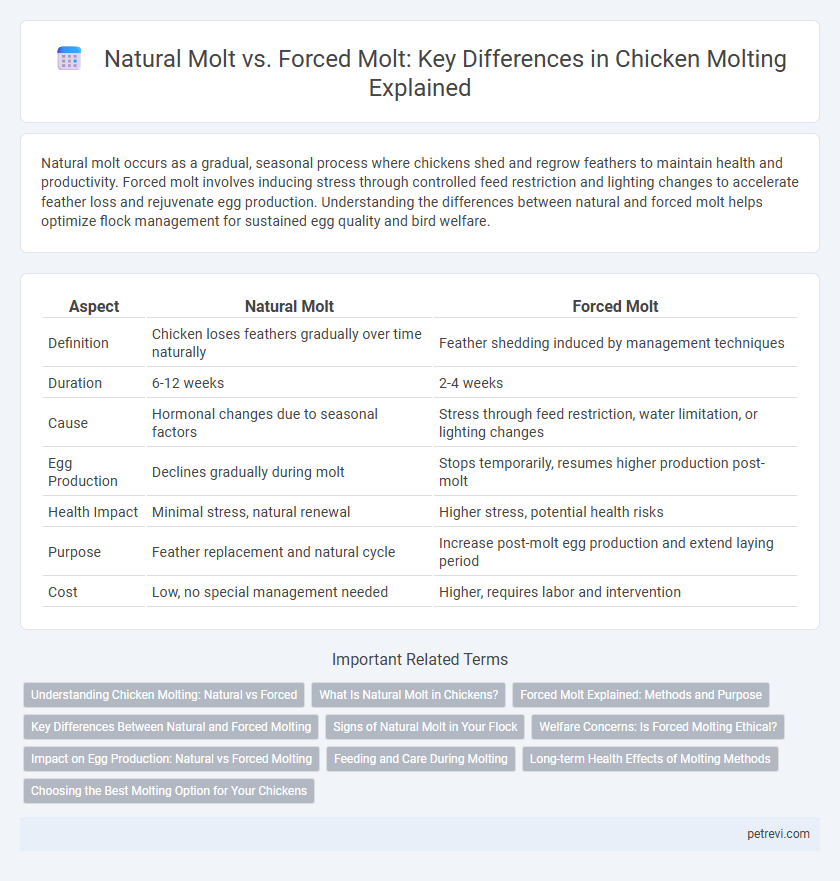Natural molt occurs as a gradual, seasonal process where chickens shed and regrow feathers to maintain health and productivity. Forced molt involves inducing stress through controlled feed restriction and lighting changes to accelerate feather loss and rejuvenate egg production. Understanding the differences between natural and forced molt helps optimize flock management for sustained egg quality and bird welfare.
Table of Comparison
| Aspect | Natural Molt | Forced Molt |
|---|---|---|
| Definition | Chicken loses feathers gradually over time naturally | Feather shedding induced by management techniques |
| Duration | 6-12 weeks | 2-4 weeks |
| Cause | Hormonal changes due to seasonal factors | Stress through feed restriction, water limitation, or lighting changes |
| Egg Production | Declines gradually during molt | Stops temporarily, resumes higher production post-molt |
| Health Impact | Minimal stress, natural renewal | Higher stress, potential health risks |
| Purpose | Feather replacement and natural cycle | Increase post-molt egg production and extend laying period |
| Cost | Low, no special management needed | Higher, requires labor and intervention |
Understanding Chicken Molting: Natural vs Forced
Natural molting in chickens occurs gradually as part of their annual cycle, allowing feathers to shed and regrow without significant stress, promoting healthy plumage and egg production. Forced molting involves controlled environmental changes such as feed restriction or altered lighting to accelerate feather loss and stimulate reproductivity, often used in commercial poultry operations to extend laying periods. Understanding the physiological differences between these methods reveals natural molting supports bird welfare better, while forced molting prioritizes production efficiency but may impact bird health.
What Is Natural Molt in Chickens?
Natural molt in chickens is a gradual, seasonal process where birds shed old feathers and grow new ones, typically occurring once a year, usually in the fall. This process is driven by hormonal changes influenced by daylight length and environmental factors, allowing chickens to maintain optimal feather quality for insulation and flight. Natural molting supports steady egg production without the stress and health risks associated with induced or forced molting methods.
Forced Molt Explained: Methods and Purpose
Forced molt in chickens involves manipulating environmental and nutritional factors to induce molting quickly, commonly using feed withdrawal or dietary restriction to trigger the process. This method aims to rejuvenate egg production in laying hens by allowing the reproductive tract to regress and then restart, resulting in improved egg quality and quantity in subsequent laying cycles. Forced molting is widely applied in commercial poultry operations to maximize productivity and extend the productive life of hens.
Key Differences Between Natural and Forced Molting
Natural molting in chickens occurs gradually, driven by seasonal changes, allowing birds to shed old feathers and regrow new ones with minimal stress and reduced egg production temporarily. Forced molting is an induced process often achieved by feed and water restriction or environmental manipulation to accelerate feather loss and restart the reproductive cycle, leading to a sharp decline in egg output but a quicker return to peak production. Key differences include the stress levels imposed, duration of feather loss, and impact on overall flock health and productivity.
Signs of Natural Molt in Your Flock
Signs of natural molt in your flock include uneven feather loss, particularly around the neck and back, and gradual replacement of old feathers with new, vibrant ones. Chickens may also reduce egg production as they redirect energy to feather regeneration. Observing a calm behavior pattern with less activity can indicate a natural molting phase, allowing for healthier feather regrowth without the stress associated with forced molting.
Welfare Concerns: Is Forced Molting Ethical?
Forced molting in chickens involves inducing stress through feed restriction or environmental manipulation, raising significant welfare concerns due to the potential for hunger, dehydration, and physiological stress. Natural molting allows birds to shed feathers and regenerate without external stressors, promoting better health and behavior consistent with animal welfare standards. Ethical considerations emphasize minimizing suffering, making natural molt a preferred method aligned with humane poultry management practices.
Impact on Egg Production: Natural vs Forced Molting
Natural molting allows chickens to gradually cease egg production as they shed feathers, promoting healthier regenerative cycles and consistent future laying. Forced molting, often induced by feed restriction or environmental changes, abruptly halts egg production but can enhance post-molt egg quantity and quality temporarily. However, forced molting can stress birds, potentially impairing long-term egg production and overall flock health.
Feeding and Care During Molting
During natural molting, chickens gradually reduce egg production while maintaining regular feeding with high-protein and vitamin-rich diets to support feather regrowth. Forced molting involves controlled fasting or restricted feeding, followed by a nutrient-dense diet to quickly stimulate feather replacement and reproductive system rejuvenation. Adequate hydration, stress minimization, and increased dietary nutrients like methionine and zinc are essential for optimal feather development and overall health during both molting processes.
Long-term Health Effects of Molting Methods
Natural molt supports the immune system and maintains bone density, contributing to stronger long-term health in chickens. Forced molt, often induced by feed restriction, can cause temporary stress and weaken the immune response, increasing susceptibility to diseases. Over time, chickens undergoing natural molting tend to recover faster and sustain better overall vitality compared to those subjected to forced molt techniques.
Choosing the Best Molting Option for Your Chickens
Natural molt allows chickens to shed and regrow feathers gradually, promoting health and minimizing stress, while forced molt uses dietary restriction or environmental changes to rapidly induce feather loss and egg production pause. Choosing the best molting option depends on your flock's health, production goals, and management capacity, with natural molt favored for welfare and forced molt for faster recovery in commercial settings. Monitoring vitamin intake and providing a balanced diet during molting supports effective feather regrowth and overall chicken vitality.
Natural molt vs Forced molt for Chicken Molting Infographic

 petrevi.com
petrevi.com